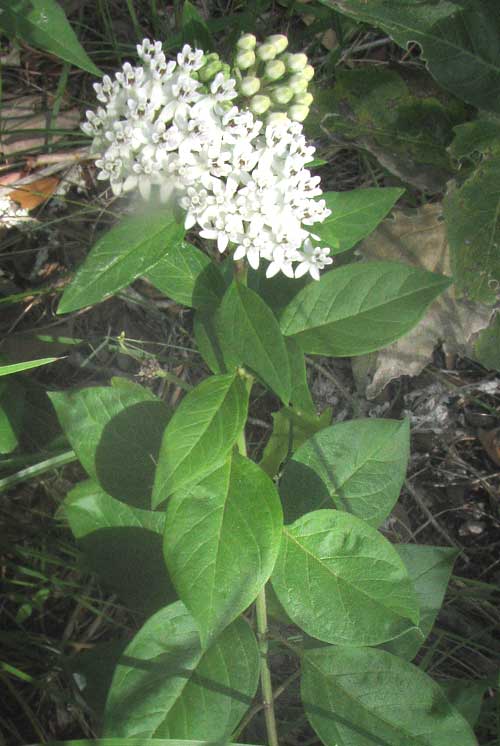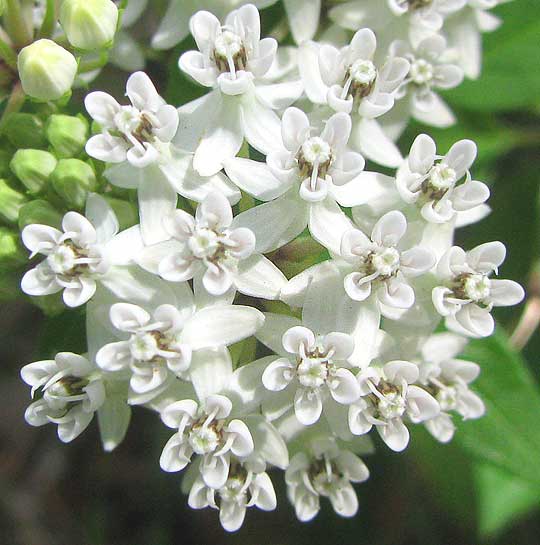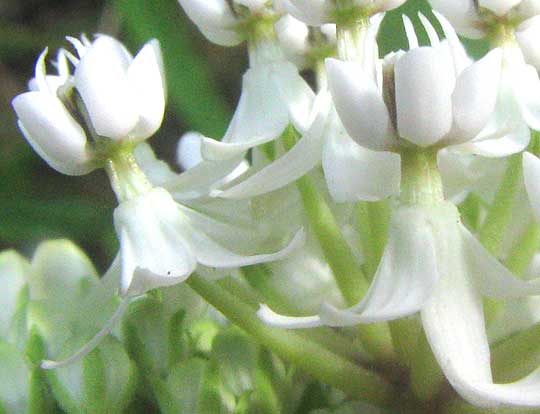Excerpts from Jim Conrad's
Naturalist Newsletter
from the August 11, 2013 Newsletter issued from the Frio Canyon Nature Education Center in the valley of the Dry Frio River in northern Uvalde County, southwestern Texas, on the southern border of the Edwards Plateau; elevation ~1750m (~5750 ft); N29.62°, W99.86°; USA
TEXAS MILKWEED
Beside a trail through the hillside forest of Ashe Junipers and Texas Liveoaks near the Center, there appeared a wildflower spectacular enough for its presence to penetrate my heat-dazed consciousness. It's shown below:

With such thick leaves arranged two per node on a stem topped with such a white snowball, even without looking at the individual flowers, this was clearly some kind of milkweed. On hands and knees looking closer, each little blossom making up a snowball displayed the very distinctive and lovely milkweed-flower structure shown below:

Milkweed flower anatomy is so complex and unusual that we have a webpage showing what's what; you may want to identify the parts of our hillside plant's flowers using the webpage's labeled pictures at http://www.backyardnature.net/fl_milkw.htm.
A side view of our hillside flowers appears below:

These flowers are very similar to those shown on our milkweed page, except that our hillside ones are all white, and the stem or "corona limb" holding the corona hoods and horns above the petals is much taller and slenderer.
This is the Texas Milkweed, ASCLEPIAS TEXANA, endemic to just a few counties in the Edwards Plateau area of southwestern Texas, far western Texas, and a couple of states in adjacent northeastern Mexico. It's described as living in sandy or sandy loam soils, or even gravel, at woodland edges, openings, ditches, ravines, depressions, along streams and river banks, which is a bit moister than where our plant occurred.
Texas Milkweed is so rare and poorly known that I find no information on its historical uses. However, all milkweeds are known to be good sources of nectar for pollinators, and caterpillars of some of our favorite butterflies, such as the Monarchs, eat the herbage.
Most milkweed leaves are unusually thick and juicy, which would seem to make them desirable to leaf-eating animals. However, milkweeds use three main defenses to limit damage caused by herbivores: hairs on the leaves; chemical toxins, and; milky latex that oozes from wounds, clogging up a herbivore's mouthparts. I've always assumed that latex and toxins in milkweed leaves were fairly sophisticated innovations, and that as such during the milkweeds' evolutionary history, those defenses mush have evolved relatively recently. However, DNA studies indicate that more recently evolved milkweed species depend less on hairs, toxins and latex than "more primitive" ancestral species. Recently arisen species are more likely to simply grow so fast that caterpillars can't keep up with the growth!